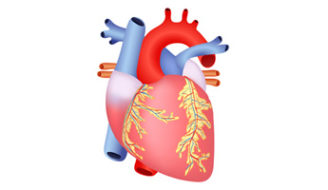
CPT 1 inhibition and heart metabolism
After inhibition of CPT 1 by Etomoxir the fatty acids utilization is limited and the other substrates as glucose, lactate and ketones are used for energy production according to the “glucose-fatty acid cycle” proposed by Randle and co-workers in (Lancet 1 (1963) 785-789).
Oxidation of glucose theoretically needs 13 % less oxygen for the same energy yield (ATP regeneration) than oxidation of fatty acids. In view of the fact that the oxygen supply in particular plays a limiting role for the heart in the most pathological circumstances, such as ischemia and hypoxia, one may expect Etomoxir to be beneficial under such conditions. This was proven by experimental results referred in the literature (ref. 33; 47; 50; 67). Considering also the fact that in patients with heart failure higher fatty acid oxidation and insulin resistance occur, a therapeutic effect of Etomoxir can be expected especially in such cases.
It has been described that under hypoxia/re-oxygenation conditions severe energy deficits occur due to an inhibition of complex I of the respiratory chain. This effect could be compensated in part by anaerobic ATP generation via α-ketoglutarate and aspartate. However, since increased fatty-acid oxidation eventually leads to the depletion of Krebs cycle intermediates such as α-ketoglutarate due to dramatically decreased glucose uptake hypoxia episodes under these circumstances lead to mitochondrial dysfunction.
Besides the change in fuel substrate utilization – from fatty acids to glucose – a great variety of intracellular metabolites, e.g. acyl-CoA derivatives, acylcarnitine derivatives, phospholipids, etc. change in concentration. The LCA-carnitine/LCA-CoA ratio decreases under Etomoxir. The accumulation of long-chain acylcarnitines induced by hypoxia is prevented and electrophysiological deterioration is abolished (ref. 64).
In animal models of heart failure and in failing human hearts, a decrease of gene expression of the SR calcium ATPase and a shift from α-myosin heavy chain to its ß-myosin isoform have been described. These molecular alterations may be associated with impairment of calcium homeostasis and contractility of the failing myocardium. Furthermore, similar alterations of the phenotype as observed in cardiac hypertrophy and failure have also been observed by altering thyroid gland activity and under calorie-rich diets. Reversal and even normalization of phenotype changes in cardiac hypertrophy and failure may therefore be achieved by specific pharmacological interventions regarding the metabolic state of the myocardium.
Etomoxir seems to alter the metabolism in the cardiocyte in the same way as observed at increased thyroid activity, sucrose feeding, and physical exercise. It leads to a “physiological or sport heart hypertrophy” in rats. This hypertrophy was associated with an increase in the α-myosin heavy chain. Furthermore, Etomoxir prevents the shift in myosin isozymes from V1 to V3 and reverses the reduced gene expression and function of the SR calcium ATPase in rat cardiac hypertrophy induced by aortic constriction. The intracellular signals for these changes in gene expression remain to be further investigated. Interesting is the fact that inhibition of CPT 2 does not show hypertrophy of the rat heart (ref. 95; 101; 102; 103; 131; 134; 136; 149; 167; 189; 203; 215; 216; 226; 261; 311).
Consistent with the experimental results in animals and the first positive results in patients with chronic congestive heart failure reported by Schmidt-Schweda and Holubarsch (ref. 228), MediGene AG has taken this as rationale to start a development of Etomoxir as a drug for the treatment of human heart failure. The first clinical phase II study was premature stopped in 2002 due to adverse effects in some cases (4 patients with increased liver enzyme activities). Without serious statistical analysis of all case reports MediGene AG decided to cancel all activities in this field. The announced toxicological concerns cannot be uphold today because statistical analysis just currently finished has given no evidence for any adverse effects caused by Etomoxir. In opposite, the data have shown very favorable effects in some metabolic parameters (triglycerides, LDL- and HDL-cholesterol) and a positive tendency in cardiac parameters (ref. 319). We agree with the experts in the field. They successed that further clinical studies with such kind of inhibitors of fatty acid oxidation are nessessary to determine the long-term benefit (ref. 217; 289; 319; 323).
